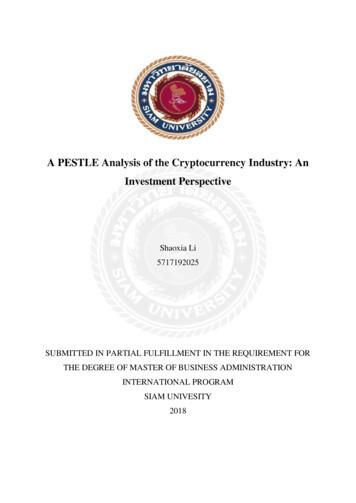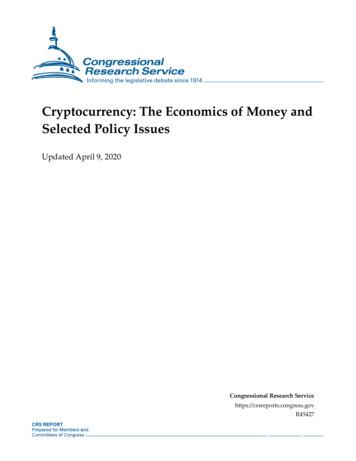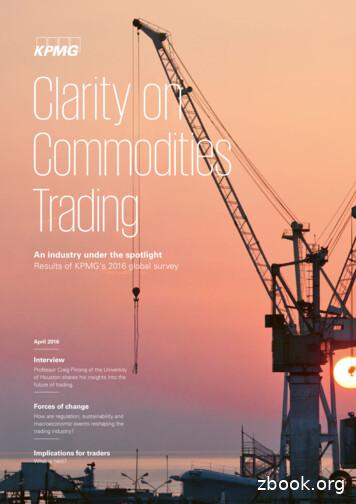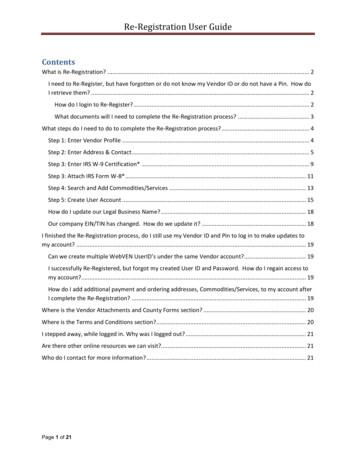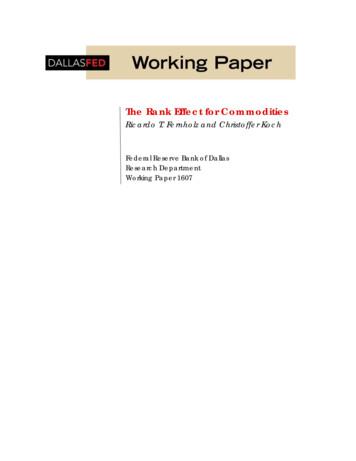Analysis Of Cryptocurrency Commodities With Motifs And LSTM
Analysis of Cryptocurrency Commodities withMotifs and LSTMBenjamin Barry and Martin CraneSchool of Computing, Dublin City University, Dublin 9benjamin.barry5@mail.dcu.ie, martin.crane@dcu.ieAbstract. Time Series Analysis has long been used as a method tohelp predict future events based on previous data. This area is welldefined and studied but there are still areas of Time Series Analysisthat are problematic. One such problem is isolating patterns in highlyvolatile datasets over long time intervals. In an effort to help with suchissues e.g. those seen in fluctuating financial datasets, a new approachis needed. Borrowing its name from Music and more recently Computational Biology, Motifs are small repeating patterns in datasets. Usingthese subsequences, further forecasting can be improved as Motifs canbe shown to aid algorithms which require certain initial conditions. Thismethod will potentially lead to new insights in the study of cryptocurrencies. This paper will present a case where an optimized Motif lengthwill be used to aid the prediction of Bitcoin through the use of an LSTMNeural Network, yielding an 8% decrease in RSME for one test case.Keywords: Time Series Analysis · Cryptocurrency · Motifs · LSTMNeural Networks1IntroductionForecasting has derived many methods for calculating the future behaviour of asystem. Statistical methods, for instance, look to predict the relationship betweenvariables when they are reduced to a simplistic expression. The area of statisticalforecasting looking at the effect time has on a system is known as Time SeriesAnalysis and this area will form the core of this work. Most aspects of forecastingTime Series data revolve around finding patterns within said data, as an attemptto see if these patterns can be projected into the future. As put forward by [12]Time Series problems can be reduced down to data pattern error. Therefore,if we can isolate the patterns and reduce the error (or noise) in a dataset we candecompose a series into something we can extend forward in time. However,what happens if the data has little to no “obvious” patterns? Here traditionalmethods can begin to fail and the picture they project becomes less accurate andhence less reliable. A new method is needed to try and better model these volatilesystems, a change in point of view from the big to the little. Using improvementsin computational power, we are no longer limited to looking at coarse granularityto try to model patterns. We can now begin to look at microscopic intervals andCopyright 2019 for this paper by its authors. Use permitted under Creative Commons LicenseAttribution 4.0 International (CC BY 4.0).
2B. Barry and M. Cranea new world of pattern repetition becomes apparent. In this paper, we look atbringing together the power of time series Motifs to optimize Neural Network’s(NNs) ability to recognise patterns.In Section 2 we examine previous research in the areas of Motifs with a specialfocus on the area of matrix profiles. We also examine prior work in Bitcoinforecasting as well as looking at some inherent challenges presented. In Section4 we detail the results of the work in terms of Similarity Scores and Occurrencesbefore looking at the overall accuracy and a comparison between LSTMs withand without Motifs. Section 4.4 discusses these results, while Section 5 concludeswith some possible future directions.22.1Related WorkMotifsCertain bodies of work have introduced Motifs (unknowingly) as opposed to ina theoretical framework for their study and evolution. For this, we need to lookto three particular papers that represent a linear progression of the work.Although there have been several co-writers across the three papers [11], [2]and [14], Eamonn Keogh features heavily in all and he can be considered theinstigator of the field. The fundamental concept of Motifs is encapsulated byKeogh in [11] where he defines a Motif as the subsequence within a time serieswhich is most similar to the most other subsequences in that series, D(Ci ,Cj ) 2R, for all 1 i K. Here R is a numeric value picked using a Distance Measuresuch as the Euclidean norm. A consequence of the definition is that all C i aremutually exclusive. In Figure 1, A, B and C are a single repeating structure foundFig. 1. A Motif in Time Series data from [2].at different points in the time series. This can be seen to be nearly identical instructure by eye and when compared mathematically they are seen to fall withinour distance range to be called the “same” i.e. our R from above.2.2Matrix Profile WorkThe goal of most research within the field of Matrix Profiles, is to reduce therun time of the Brute Force approach (O(n2 m) [11]). The method known as
Analysis of Cryptocurrency Commodities with Motifs and LSTM3STAMP (Scalable Time series Any-time Matrix Profile) uses the Fast FourierTransform to reduce the computation time to O(n2 logn) [2]. The method usedhere is STOMP (Scalable Time series Ordered-search Matrix Profile) which runsin O(n2 ) [10]. In this algorithm, through algebraic changes that better use thecomponent order and invariance of the matrix, run time is improved.The algorithm uses Piecewise Aggregate Approximation to reduce dimensionality and then Discretization is performed to transform the time series into“Words” which can be easily compared. This allows for a more efficient calculation of distances exactly [14] (unlike other methods).2.3Bitcoin and its Modelling ChallengesOperating under the pseudonym “Satoshi Nakamoto”, a developer published apaper [15] where they propose the idea of a Cryptocurrency. From that pointonwards the rise of cryptocurrencies has been exponential and highly volatile 1 .The rise and fall of Bitcoin has led many to try to predict what it will do next [4].The price of Bitcoin has been modelled by, among others, Krystoufek [9] whofound by studying Bitcoin Price according to fundamental Economic laws, theprice is not ever-increasing. Since 2018 Bitcoin is close to its model-implied price.This finding would seem to back up the notion that Bitcoin had entered a MaturePhase [4]. Due to the (relatively) low amount of trading done on Bitcoin pre-April2017, the price remained less volatile. With Bitcoins increased popularity, itsvalue changed wildly from day to day. Hence Bitcoin is best considered in 2 ages,its Immature state and its Mature state. As the price of Bitcoin in the Immaturestate has been found to be almost perfectly correlated with other Cryptocurrencyprices [3], this has given rise to arbitrage opportunities which have been pursuedas a means to find the ”next” Bitcoin. Further investigation of the variability ofBitcoin price has taken the form of research into existence of regime changes inthe price, [8] found that Recurrent Neural Networks outperform Hidden MarkovModels at predicting volatility spikes.Other authors have also found challenges due to the extreme fluctuations seenin the Bitcoin market over small increments of time. For example in July 2017,its value increased 25% in a single day. Previous research has attempted to solvethe problem using the correlation between the number of transactions and price.This yielded positive results for Bitcoin returns without, however, being ableto predict volatility [1]. The issue with this approach is the need to know thenumber of transactions in order to create a prediction. A method is needed thatcan model forward the market with less restrictive input parameters.A statistical approach is taken by Shah and Zhang [16] where they use BayesianRegression to model future values of Bitcoin. They achieve good results withthis approach and are able to nearly double their initial investment in less thana 60-day period.LSTM RNNs have been found to be an efficient way to predict Bitcoin pricefrom historical prices and moving average technical indicators. Other Machine1Its max value over 18,000 to current 8,000 (coinbase.com/price/bitcoin).
4B. Barry and M. CraneLearning methods, e.g. [13] found LSTM RNNs produced the highest accuracy onprice prediction. [6] used LSTM model to predict Bitcoin price with, as modelinputs, macroeconomics factors such as global currency ratios and blockchaininformation. [7] have used them to mine news articles and tweets to infer therelationship between their information, certain commodity prices and Bitcoinprice direction yielding an accurate prediction technique.(a) Immature Bitcoin(b) Mature BitcoinFig. 2. Historical Bitcoin Graphs33.1MethodsMatrix ProfilesWhat underpins the Keogh algorithms [11], [2] and [14] is the concept of aMatrix Profile. In essence, this reduces a time series T into a matrix where eachcell represents the distance between a subsequence and all other subsequencesof equal length in the time series. This produces a matrix of size N by N (Nis the length of the time series T less the length on the subsequence). For atime series T with 100 data points the Matrix Profile for all subsequences oflength 10, would consist of a 90 by 90 matrix. A common metric used is thez-normalized Euclidean distance due to its ability to account for variance andmean. Consider Figure 3, where the blue and red lines represent 2 different timeFig. 3. Euclidean Distance between subsequencesseries T and S. Here the 2 series are mapped on top of each other over a period
Analysis of Cryptocurrency Commodities with Motifs and LSTM5of time with arbitrary values on the y-Axis. The vertical lines show the distancebetween corresponding points on each series (i.e at the same point in time). Themodified sum of these distances represents the Euclidean distance at a simplifiedlevel. For Motifs, we are only interested in the lowest distance value i.e. the mostsimilar subsequence.3.2Data UsedThree separate time granularities were chosen for both the Mature and Immaturedata within Bitcoin. Since the Poloniex2 data source was accurate to 5-minutes,this was the lowest granularity picked. From here, 15-minute and 30-minuteintervals were also chosen.This data counts are shown in Table 1. Graphs of theMature and Immature Bitcoin data are shown in Figure 2.Table 1. Dataset SizeDataset GranularitySize5 Minutes 221,829Immature 15 Minutes 73,93730 Minutes 36,9655 Minutes 236,421Mature15 Minutes 78,78930 Minutes 39,3814Results4.1Matrix Profile OutputsA sample of the standard STUMPY algorithm outputs are seen in Table 2.This table shows the Starting position of a subsequence (Index ), the EuclideanDistance (Similarity) to its closest copy, the starting index of where that copyis (Start) and how often the pattern occurs (Occurrence).Table 2. 3 Matrix Profile - Immature 5 MinutesIndex Similarity Start Occurrence2https://poloniex.com/00.33437 21
6B. Barry and M. Crane4.2Matrix Profile GraphsThe data in Table 2 can be used to create an overall result for all granularitieswithin the data set graphically. Figure 4 shows the Similarity (Euclidean Distance) of each subsequence of length 3, 6, 12, 24 and 48. With Figure 4(e) asone of the clearest examples, we can see peaks within the graph or “Discords”.These can be considered the opposite of Motifs i.e. they represent seldom repeating occurrences or anomalies. The lower the value on the y-Axis the closerthe Motifs are to each other, i.e. over larger windows we can see the SimilarityScore increasing so the Motifs are becoming less similar.4.3Long Short Term Memory (LSTM)Due to the large number of points in the input data (Immature 15-minutes andMature 15-minutes) and limited hardware resources3 the LSTM NN takes a lotof time to run. The computation times were noted as 23.1 hours, 7.5 hours and26.6 hours, 8.4 hours on the Mature and Immature dataset running the Motifand the standard algorithm respectively. A comparison can be made betweenour version (with Motifs) and a standard 1 point LSTM NN in Figures 7 (a) & 8(a) for the Mature and Immature cases respectively. Table 3 show Mean SquareError for the Trained and Tested case for Mature and Immature for Motifs withLSTM NN and the 1 point LSTM NN.Table 3. LSTM Mean Square 3Test1,832.49DiscussionOptimum Motif Length The goal from analysis of the outputs is to attemptto find an “Optimized” Motif that we can then pass into the LSTM to try toimprove its accuracy. To do this, it was best to compare the Motif lengths across3The code was run on an Intel i7-5600 CPU @ 2.60GHz with 8GB of RAM
Analysis of Cryptocurrency Commodities with Motifs and LSTM7(a) Matrix Profile Immature 5 Minutes(b) Matrix Profile Mature 5 Minutes(c) Matrix Profile Immature 15 Minutes(d) Matrix Profile Mature 15 Minutes(e) Matrix Profile Immature 30 Minutes(f) Matrix Profile Mature 30 MinutesFig. 4. Matrix Profile for Different Granularities
8B. Barry and M. Cranetwo metrics: Similarity Scores and Motif Occurrence. Hence, to establish whichMotif length to input, each will have to be taken into account and an overall bestvalue will need to be selected. The answer from this section mixes the qualitativeand quantitative. We need to visually interpret graphical outputs, in conjunctionwith the underlying numeric scores. As such, the optimum Motif length is opento interpretation.Similarity Score For both the Mature and Immature dataset for the five subsequence lengths tested, an output as seen in Table 2 was created. The longerMotifs tend to get less similar (this makes sense intuitively with more pointsto calculate the Euclidean distance between). The pitfall at this point wouldbe to just consider the length 3 Motif as the best option due to it having thesmallest mean Euclidean distance. However, we must consider the reason behindthis. Figure 5 contains the graphed Similarity Score (in intervals of 0.5 wherethe final value on the x-Axis contains all values above it). All these graphs showthe dominance of the zero score Motifs. These occur often at low granularitydue to minute differences in Bitcoin’s value. These effectively are straight linesin the graph. This behaviour is dominant in the 5-minute 3 and 6 length Motifs(it is also dominant in most of the Immature data due to the lack of trading atthe beginning of Bitcoins life). We need to find the best compromise betweenhigh Similarity Scores and the dominance of the straight-line “0” score. In allsix graphs in Figure 5, the blue (3 Motif) and the orange (6 Motif) plots aredominated by the 0 score Motifs, while the purple (48 Motif) plot occurs moreoften at the higher values. The green (12 Motif) plot and the red (24 Motif)plot are our best compromise. Of note in these graphs is the apparent Gaussiandistribution sitting on the spread of some scores (this is most obvious for the red(24 Motif) plots). This may be explained using the Law of Large Numbers [5].Due to the lack of dominance of the 0 score and as the there are fewer largerscores, the values are tending towards their Expected Value. This effect is morepronounced in the Mature dataset due to the movement of Bitcoin towards atraditional commodity [4]. To split our choice between a 12 Motif and 24 Motifwe consider the Occurrence counts of our Motifs.Motif Occurrence When we speak of the “Occurrence” of a Motif we arereferring to how often it appears in a dataset. If we look back to Table 2 wecan explain the field as how many times the Start, i.e. the starting index of therepeating subsequence relative to the Index, occurs. This is to say that the subsequence at Index 0, along with 26 other subsequences are most similar to thesubsequence at Index 14292. This means the Motif repeats throughout the timeseries multiple times. Although all 27 subsequences may not have the same Similarity Score as 0, they will form a Motif. Highly repeating structures are againusually akin to straight lines and often, after a further look, are uninformative.Due to the high number of possible values for the Occurrence in the graphs, thevalues need to be bucketed: Anything with an Occurrence value of 1 or 2 is keptas is, whilst 3-5, 5-10 and 10-50 are grouped and finally anything above 50 are
Analysis of Cryptocurrency Commodities with Motifs and LSTM9(a) Similarity Scores Immature 5 Minutes(b) Similarity Scores Mature 5 Minutes(c) Similarity Scores Immature 15 Minutes(d) Similarity Scores Mature 15 Minutes(e) Similarity Scores Immature 30 Minutes(f) Similarity Scores Mature 30 MinutesFig. 5. Similarity Scores for Different Granularitiesincluded in the 50 bucket. Subsequences with an Occurrence value in thesecategories are counted and used as the y-Axis value. In Figure 6, we are interested in the green (12 Motif) and red (24 Motif) plots from analysis in Section4.4. From the graphs there is little to choose between the two Motif lengths. Ingeneral, the green plot seems to have more of the undesired Occurrence valuesof 1 and Occurrence values in the 50 range. Hence, we can select the 24 Motifas the best option between the two and proceed to using it in the LSTM NN.4.5LSTM AccuracyThe LSTM NN was not optimized as that was not the goal of this paper, as such,some of the hyperparameters chosen are not useful in a real world scenario. Thisis especially true of the batch size of 1. An increase here would have reducedthe computation time. In this sense there is little to no value in using the computation times as a metric to measure if the Motif using LSTM outperforms atraditional LSTM.
10B. Barry and M. CraneThe simple goal of the LSTM NN is to see does using Motifs as an intermediary step between raw data and model help our outcome. Thus Figures 7 (a) and(b) let us compare our Motif version to the standard version of the algorithm forthe Mature dataset. It is clear that the former tracks its training data much moreeffectively. What is very obvious is that after only 25 epochs the test outputs(a) Motif Repetition Immature 5 Min- (b) Motif Repetition Mature 5 Minutesutes(c) Motif Repetition Immature 15 Min- (d) Motif Repetition Mature 15 Minutesutes(e) Motif Repetition Immature 30 Min- (f) Motif Repetition Mature 30 MinutesutesFig. 6. Motif Occurrence for Different Granularities
Analysis of Cryptocurrency Commodities with Motifs and LSTM11trend very closely to the true values, just shifted down in value by roughly 750.Table 3 shows a reduction in the test RMSE by 8% and training of 24%. Thereare significant computation time increases (66%), but with script optimizationand better hardware this could be reduced. Figures 8 (a) and (b) show the effectintroducing Motifs has to the Immature dataset. Table 3 shows us that there isa reduction in the test RSME by 33% and training of 50%.(a) LSTM NN for Mature Bitcoin using Motifs(b) LSTM NN for Mature Bitcoin not using MotifsFig. 7. LSTM NN for Mature Bitcoin With and Without Motifs(a) LSTM NN for Immature Bitcoin using Motifs(b) LSTM NN for Immature Bitcoin not using MotifsFig. 8. LSTM NN for Immature Bitcoin With and Without Motifs5ConclusionThe goal of this work was to study the application of Motifs in pattern detectionin volatile data. The computation speed and exactness of the Matrix Profilemake it a powerful tool and results back this. Future work could be to furtherintegrate Motifs into LSTMs by putting Motifs in the individual NN nodes. If,training a LSTM, a recognised Motif occurred, forcing the node to abandon itsstandard approach of randomizing the weights matrix and simply complete theMotif could help our learning rate. This would require a more proficient NN tobe built to better handle the computations and reduce run-times.There is the potential that capturing enough Motifs in a sequence could replace
12B. Barry and M. Cranea series with a Motif piecewise reduction, reducing the total information storedby potentially multiples of bits. All these are possible future directions.The work presented here is a simple use of Motifs in a practical way. The resultsindicate that there is strong potential to embed Motifs in different areas ofComputer Science.6AcknowledgementsThe authors are grateful to Prof. H. J. Ruskin for her helpful comments. Thisresearch was (partially) conducted with the financial support of SFI under GrantAgreement No. 17/SP/5447 at the ADAPT SFI Research Centre at DCU. TheADAPT SFI Centre for Digital Media Technology is funded by Science Foundation Ireland through the SFI Research Centres Programme and is co-fundedunder the European Regional Development Fund (ERDF) through Grant no.13/RC/2106.References1. Balcilar, M., Bouri, E., Gupta, R., Roubaud, D.: Can volume predict Bitcoin returns and volatility? Economic Modelling 64, 74–81 (2017)2. Chiu, B., Keogh, E., Lonardi, S.: Probabilistic discovery of time series motifs. In:Proc. of 9th Int. Conf. on KDD, Washington, DC, Aug 24 - 27 (2003)3. Cretarola, A., Figà-Talamanca, G.: Detecting bubbles in Bitcoin price dynamicsvia market exuberance. Annals of Operations Research (Jul 2019)4. Drozdz, S., Gebarowski, R., Minati, L., Oswiecimka, P., Watorek, M.: Bitcoin market route to maturity? CoRR abs/1804.05916 (2018)5. Feller, W.: The strong law of large numbers. In: An introduction to probabilitytheory and its applications, vol. 1(3), pp. 243–245. Wiley (1968)6. Jang, H., Ko, H., Lee, J., Lee, W.: Predicting bitcoin prices by using rolling windowlstm model. In: Proc of KDD Data Science In Fintech Workshop (DSF) (July 2018)7. Kinderis, M., Bezbradica, M., Crane, M.: Bitcoin currency fluctuation. In: 3rd IntConf on Complexity, Future Information Systems and Risk, 20-21 Mar (2018)8. Kodama, O., Pichl, L., Kaizoji, T.: Regime change and trend prediction for Bitcointime series data. In: CBU Int. Conf. Proc. vol. 5, pp. 384–388 (2017)9. Kristoufek, L.: Is the Bitcoin price dynamics economically reasonable? Physica Ap. 120873 (2019)10. Law, S.M.: STUMPY: A powerful and scalable python library for time series datamining. The Journal 4 (2019)11. Lin, J., Keogh, E., Lonardi, S., Patel, P.: Finding motifs in time series. Proceedingsof the Second Workshop on Temporal Data Mining pp. 53–68 (10 2002)12. Makridakis, S., Wheelwright, S., Hyndman, R.: Forecasting methods and applications. John Wiley & Sons (2008)13. McNally, S., Roche, J., Caton, S.: Predicting the price of bitcoin using machinelearning. In: 26th Euromicro Int Conf on Parallel, Distributed and Network-basedProcessing (March 2018)14. Mueen, A., Keogh, E., Zhu, E., Cash, S., Westover, B.: Exact discovery of timeseries motifs. In: Proc 2009 SIAM Int conf on data mining. pp. 473–484 (04 2009)15. Nakamoto, S.: Bitcoin: A peer-to-peer electronic cash system (2008)16. Shah, D., Zhang, K.: Bayesian regression and Bitcoin. In: 52nd Allerton Conf onCommunication, Control, and Computing, Monticello, IL, Sept 30 - Oct 3 (2014)
Analysis of Cryptocurrency Commodities with Motifs and LSTM 3 STAMP (Scalable Time series Any-time Matrix Pro le) uses the Fast Fourier Transform to reduce the computation time to O(n2logn) [2]. The method used here is STOMP (Scalable Time series Ordered-search Matrix Pro le) which run
Rout not over for commodities as CRB uptrend ends Time to move some money to stocks from commodities Commodities margins: art, science or politics? Rout rids commodities of speculative froth, fundamentals intact Oil, other commodities still too pricey for China Commods likely to recover after short correction-MF Global
This paper provides a concise yet comprehensive analysis of the cryptocurrency industry using the PESTLE model with a focus on Bitcoin and its investment. 1.6 Research Methods This paper is based on a descriptive study focuses on secondary data, the majority of information comes from journal articles, news, opinions from cryptocurrency .
when they sell the same cryptocurrency into fiat currency later on. Taxation of Cryptocurrency Block Rewards: Comparative Summary . The Law Library of Congress 3 . The income tax treatment of mining is
Understanding Cryptocurrency (updated May 2018) Ari Paul. CIO, Managing Partner. BlockTower Capital. Cryptocurrency is at the intersection of game theory, cryptography, computer science, economics, venture capital, and public markets. Don’t be scared. These
Apr 09, 2020 · of blockchain technology, cryptocurrency systems protect their public ledgers of accounts against manipulation, so that users can only send cryptocurrency to which they have access, thus allowing users to make val
Hypothesis 5: Reddit sentiment performs as a strong predictor over cryptocurrency prices forecasting. CryptoCurrency 2. Data collection 2.1 Reddit comments data Reddit has the official PRAW API (https://praw.readthedocs.io) for data scraping. However, the PRAW API only provides access to recent commentary data.
“The perishable agricultural commodities listed on this invoice are sold subject to the statutory trust authorized by section 5(c) of the Perishable Agricultural Commodities Act, 1930 (7 U.S.C. 499e(c)). The seller of these commodities retains a trust claim over these commodities, all
Clarity on Commodities Trading 3 Making the world go round Richard Sharman Global Head of Commodities Trading Commodities make the world go round. While consensus suggests the low-price environment is here to stay, it looks like medium-term structural fundamentals will ease t
commodities strategy, while a small percentage even invested directly in commodities such as farmland or timberland. Those institutions that do not believe commodities to be alternative investments primarily responded that they do invest in commodities but consider it a core allocation. Advisors' responses indicated a slightly lower
To select a Commodities and/or Service you must click the button to the left of the field. The selected Commodities and/or Service will be loaded into section labeled: Commodities / Services You Have Selected. Selecting the button will open up a filtered class list of the Commodities and/or Services that fall within that 3 digit class code.
Algorithmic Trading of Cryptocurrency Based on Twitter Sentiment Analysis Stuart Colianni, Stephanie Rosales, and Michael Signorotti F . Python library for accessing the Twitter API [10]. The keyword,bitcoin, is searched in real
Source: BMO Economics Unless otherwise specified, all indices reported in this publication correspond to prices in U.S. dollars. Commodities Outlook Commodities Outlook for November 2019
2. Duty System of Hong Kong 2.1 Hong Kong is a free port with no general tariff on imported goods. Excise duties are charged on four commodities, whether they are imported or manufactured locally, for domestic consumption. These commodities are certain hydrocarbon oil (motor s
- COMMODITIES THE KEY TO THIRD WORLD DEVELOPMENT 4 I. World trade in commodities 4 II. The vital importance of commodities to the Third 7 World III. Not all in the same boat 8 . its conclusions are still valid. The 66 products on the UN lists can be divided into three categories :
China still drives many commodities But supply-constrained commodities likely to outperform With China and Trump, actions speak louder than words. But words matter too for sentiment What China gives, China can take away "They suck the blood out of us, and we owe
Commodities: A bumpy ride Commodities have had a bumpy few weeks, with benchmarks retreating from their October highs. Renewed COVID-19 uncertainty has weighed, especially on oil, while volatility in gas/power markets stays abnormally high. Gold has failed to benefit, as central banks seem to be going ahead with plans to tighten monetary policy.
For 1882 { 1913, these commodities are barley, beef, copper, cotton, hemp, jute, lead, mutton, oats, rice, silver, sugar, tea, tin, and wheat. 7 portfolio of higher-ranked commodities was 6.4%. Furthermore, as Fernholz (2016b) shows, the correlation between these excess returns and monthly Russell 3000 stock returns is -0.13.
include initial coin offerings or security token offerings (collectively, “ICOs”) to fund the issuer’s or promoter’s own business or project. Instead, ICOs are regulated under a separate regime, on which see below. Blockchain and cryptocurrency regulation 2019, first edition 3
Bitcoin and cryptocurrency technologies: a comprehensive introduction Princeton University Press, 2016. [2.4] Narayanan, Arvind, et al., How Bitcoin Achieves Decentralization, Chapter 2 in Bitcoin and cryptocurrency technologies: a comprehensive introduction, ibid. Week 3 Jan 22,34 Bitcoin and its variants [3.1] Nakamoto, Satoshi.
physiquement un additif alimentaire sans modifier sa fonction technologique (et sans avoir elles-mêmes de rôle technologique) afin de faciliter son maniement, son application ou son utilisation . Exemples . Conclusion Les additifs alimentaires sont présents partout dans notre alimentation . Attention à ne pas minimiser leurs impacts sur la santé . Title: Les Additifs Alimentaires Author .


